
Are you tired of rummaging through your cluttered pantry, searching for that one ingredient you need? You’re not alone! A disorganized pantry can turn cooking into a frustrating experience, wasting your time and even leading to food waste.
Imagine having a pantry that’s not just tidy but also functional. With the right pantry storage strategies, you can transform your kitchen into a haven where cooking is a joy, not a chore. By organizing your pantry, you’ll save money by preventing unnecessary purchases and reducing food waste.
In this article, we’ll explore comprehensive pantry storage solutions that can be adapted to your specific needs, whether you have a walk-in, reach-in, or cabinet pantry. You don’t need to undertake a complete renovation or invest in expensive products to achieve an organized kitchen.
Key Takeaways
- Discover how to transform your pantry into a functional space.
- Learn strategies to prevent food waste and save money.
- Understand how to adapt pantry storage solutions to your kitchen needs.
- Explore simple and cost-effective ways to organize your pantry.
- Get actionable steps to implement pantry organization strategies.
Why Pantry Organization Matters

A cluttered pantry can be a source of daily frustration, but organizing it can transform your kitchen experience. You’re not alone in feeling overwhelmed by the chaos within your pantry.
The Impact of a Well-Organized Pantry
A well-organized pantry has a significant impact on your daily life. It saves you time by allowing you to quickly locate the ingredients you need. This, in turn, can make cooking more enjoyable and reduce stress. With a clear view of your storage space, you can better plan meals and make grocery lists.
Common Pantry Problems to Solve
Many common issues plague pantry organization, including:
- “Pantry avalanches” where items tumble out when reaching for something specific
- “Black hole corners” where things disappear and expire before being rediscovered
- Wasted vertical space in standard pantries with fixed shelving
- Managing bulk purchases alongside everyday items in limited space
- Difficulty maintaining organization systems that aren’t intuitive for all family members
- Poor lighting that makes it hard to see what’s available
- Struggling to keep track of expiration dates when items aren’t visible or properly arranged
By addressing these challenges, you can create a pantry that is both functional and stress-free.
Getting Started: Declutter and Assess Your Space

Before you start organizing your pantry, it’s essential to declutter and assess the space you have. This initial step is crucial for creating an efficient storage system that works for you.
Removing Expired Items
Begin by taking everything out of your pantry and sorting items into categories. Check expiration dates and get rid of any expired or spoiled food. This process not only frees up space but also helps you understand what you have and what you need to store.
Evaluating Your Current Shelving Setup
After decluttering, evaluate your current shelving setup. Measure your pantry dimensions and shelves spacing to identify areas for improvement. Consider whether your current configuration makes the most of your storage space. Ask yourself if your shelving is too deep or if the shelves are too far apart, making it hard to access items.
To optimize your pantry storage, consider the ideal shelf depth and spacing. Typically, a depth of 12-16 inches is recommended to prevent items from getting lost in the back. Take inventory of the items you need to store to determine the optimal shelving configuration. Sketching a pantry plan before making changes can help ensure your new layout accommodates all your needs.
Clear Containers: The Foundation of Pantry Storage Solutions
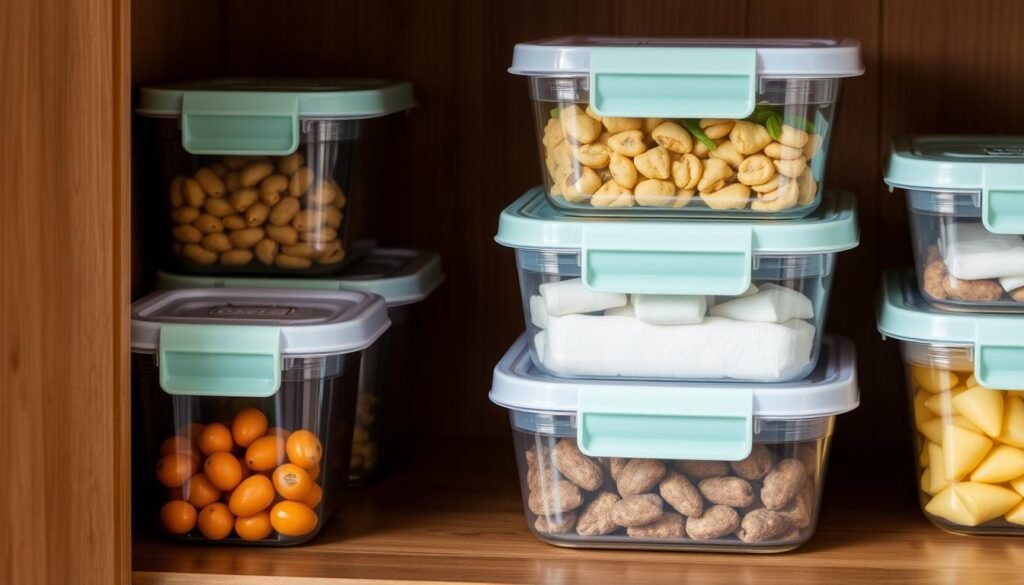
When it comes to pantry storage, clear containers are the unsung heroes that keep your kitchen organized and clutter-free. Clear bins or containers are an excellent way to keep your pantry items organized while keeping them visible.
Benefits of Decanting Dry Goods
Decanting your dry goods into clear containers has several benefits. It makes it easy to see everything you have, avoiding buying duplicates of what you already own. This simple switch can significantly reduce clutter and make meal planning more efficient.
Best Container Types for Different Items
Different pantry staples require different container types. For instance, tall, narrow containers are perfect for storing pasta and rice, while shallow, wide containers are better suited for flour and sugar. Small containers are ideal for spices and baking powder.
The material of your containers also matters. Glass containers are non-porous and don’t absorb odors, making them perfect for storing spices. Plastic containers are lightweight and shatterproof, ideal for storing heavy items like canned goods or bottles. Acrylic containers combine the benefits of both glass and plastic, offering a durable and versatile storage solution.
Smart Shelving Strategies
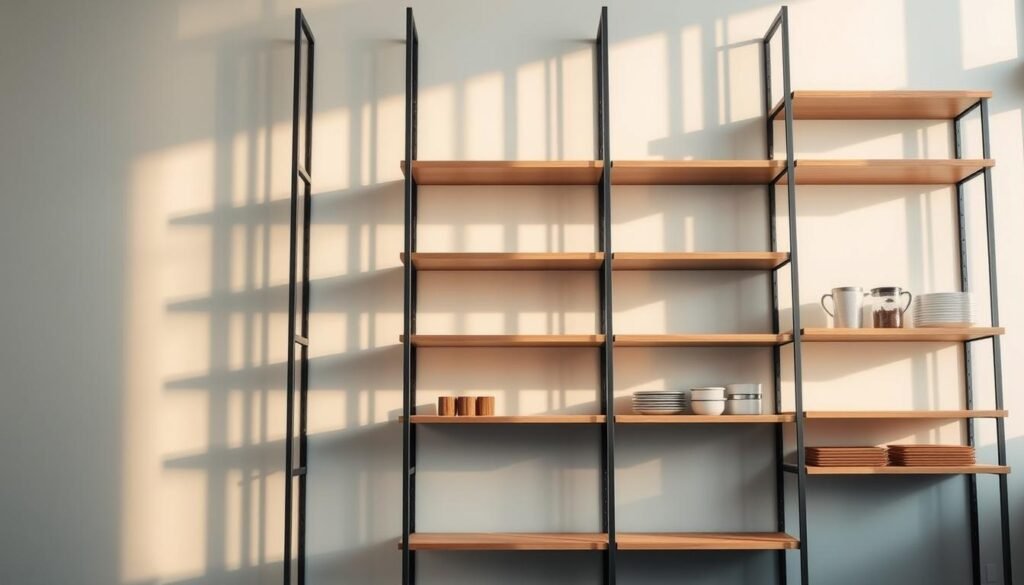
To maximize your pantry’s storage potential, consider implementing smart shelving strategies. This involves optimizing shelf spacing and utilizing vertical storage solutions.
Optimal Shelf Spacing and Depth
Adjusting shelf spacing and depth can significantly impact storage capacity. Consider the size of items and adjust shelves accordingly. Deeper shelves accommodate larger containers, while narrower shelves suit smaller items.
Adding Shelf Risers for Vertical Storage
Using shelf risers creates additional storage layers, maximizing vertical space. Expandable shelf risers fit different shelf widths, improving visibility and accessibility. “You can effectively double or triple your shelf space!”
Maximize Vertical Space

One of the most effective ways to boost your pantry’s storage capacity is by utilizing vertical space. This approach allows you to store more items without cluttering your shelves.
Utilizing Wall Space for Storage
You can make the most of your pantry’s walls by installing shelves or storage units that go up to the ceiling. This is particularly useful for storing infrequently used items like special occasion dishes or out-of-season cookware. Consider using decorative baskets or bins to keep these items organized and out of sight.
- Install shelves or storage units that reach the ceiling to maximize storage.
- Use decorative baskets or bins to store items on high shelves.
Ceiling-Height Solutions
Take your shelving all the way to the top to capture often-wasted upper space. Store infrequently used appliances, tools, and ingredients up high. Don’t forget to keep a stepping stool handy for safe access. Consider installing a rolling library ladder for tall pantries or using ceiling-mounted hooks for lightweight items.
- Store infrequently used items on the highest shelves.
- Use a stepping stool or rolling library ladder for safe access.
- Install ceiling-mounted hooks for hanging lightweight items.
Basket and Bin Organization
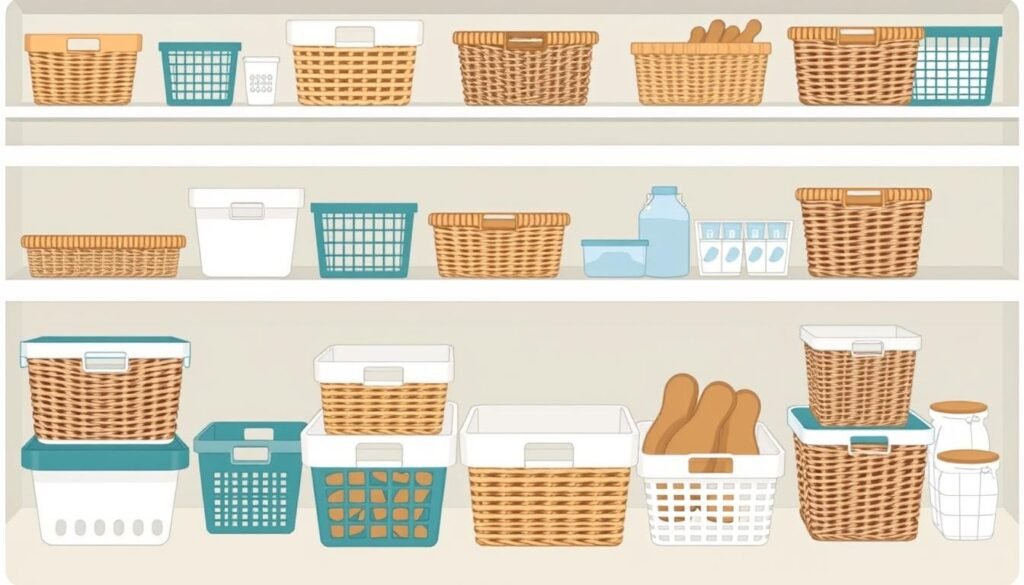
When it comes to pantry storage, baskets and bins are essential for maintaining order and accessibility. They help keep items off shelves and make the most of your pantry’s vertical space.
Choosing the Right Containers
Selecting the appropriate containers is crucial for effective pantry organization. Consider the size, material, and style that best suits your needs. For instance, clear bins allow you to see contents at a glance, while woven baskets add a decorative touch.
Labeling Systems That Work
Labeling your baskets and bins is a game-changer for pantry organization. It creates a system that everyone in the household can follow, making it easier to maintain order. You can opt for handwritten labels, printed tags, or even chalkboard labels, depending on your preference and the overall aesthetic of your pantry.
Consistent labeling transforms individual efforts into a cohesive system, reducing the time spent searching for items and making restocking more efficient. Consider categorizing items broadly and using pictorial labels for households with young children or non-readers.
Door and Wall Storage Solutions

To create a truly organized pantry, consider the often-overlooked areas of door and wall storage. These spaces can be transformed into functional storage areas, enhancing your pantry’s overall efficiency.
Over-the-Door Organizers
Over-the-door organizers are a simple and effective way to add storage without compromising floor or shelf space. You can use them for storing items like cleaning supplies, bags, or even small kitchen gadgets. Adjustable hooks and baskets can be particularly useful, allowing you to customize the space according to your needs.
Wall-Mounted Options
Wall-mounted shelving, racks, and organizers can significantly increase your pantry’s storage capacity. As Ursula Carmona of Homemade by Carmona did, you can install a wall-mounted organizer for items like vacuums and brooms, freeing up floor space and reducing clutter. Consider using adjustable track systems that allow for customization as your storage needs change.
When implementing wall storage, it’s crucial to choose the right wall anchors and installation methods to safely support the weight of your pantry items. You can also explore space-saving solutions like folding shelves that can be collapsed when not in use. By thoughtfully incorporating wall-mounted elements, you can maintain a cohesive design while maximizing your pantry’s storage potential.
Creating Functional Zones in Your Pantry
You can transform your pantry into an efficient space by establishing clear zones. This simple yet effective approach helps you locate items quickly and makes meal preparation more streamlined. By dividing your pantry into functional areas, you create a system that adapts to your household’s needs.
Organizing by Food Type
One effective way to zone your pantry is by categorizing items by food type. For instance, you can have a section for grains, another for canned goods, and a separate area for snacks. This method makes it easier to find what you need when cooking. Grouping similar items together simplifies meal prep and grocery storage.
Frequency-of-Use Arrangement
Another strategy is to organize your pantry based on how frequently you use certain items. Store your everyday items at eye level for easy access, while less frequently used items can be placed above or below. Rarely used items can be stored in harder-to-reach areas or towards the back of higher shelves. This arrangement minimizes reaching and bending, making your pantry more user-friendly.
To implement this effectively, evaluate your household’s usage patterns. Consider creating a “this week’s meals” zone at eye level that rotates based on your meal plan. This approach not only streamlines dinner preparation but also ensures that you’re making the most of your pantry space. By combining food type categories with frequency-of-use principles, you can achieve the most intuitive organization for your pantry, making it a functional and efficient part of your kitchen.
Kid-Friendly Pantry Organization
Creating a kid-friendly pantry is not just about making snacks more accessible; it’s about teaching your children valuable life skills. By organizing your pantry in a way that’s easy for kids to navigate, you’re encouraging them to take part in meal prep and cooking.
Accessible Snack Stations
One way to make your pantry more kid-friendly is by creating accessible snack stations. Using floor baskets or low shelves, you can make it easy for kids to grab what they need without having to ask for help. As the data suggests, “Floor baskets are also a great option for making kid snacks easy to reach if you still have little kiddos!”
Teaching Independence Through Organization
Teaching kids to be independent in the kitchen starts with organization. By creating visual systems with pictures or color-coding, you can help them understand where things belong. Some age-appropriate pantry tasks for kids include:
- Selecting snacks
- Helping restock and organize
- Assisting with meal prep
Involving kids in the labeling process can also increase their connection to and understanding of the system. As they grow, designated kid zones can evolve from simple snack access to more complex meal preparation areas.
Specialty Storage for Canned Goods
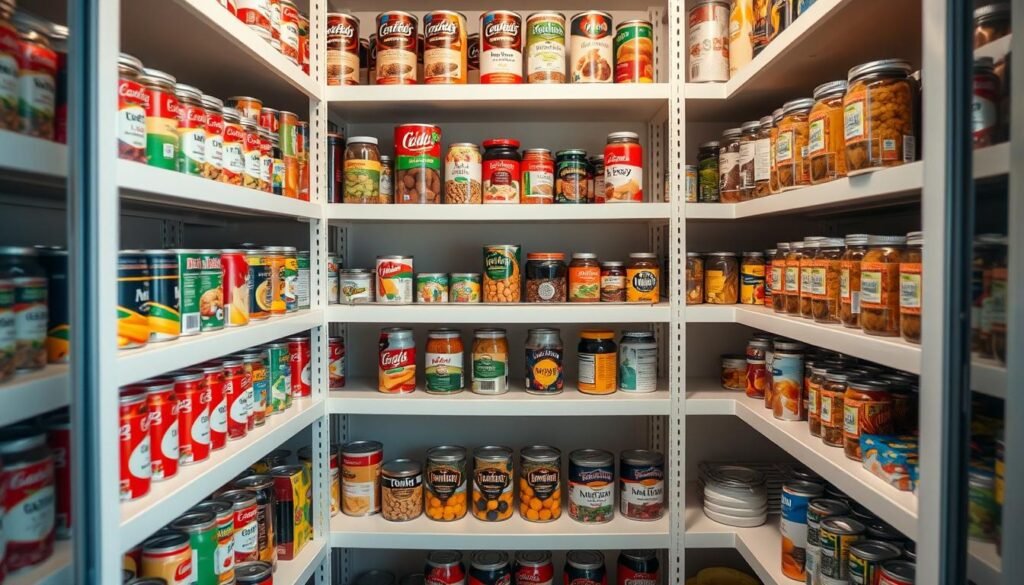
Effective storage for canned goods is crucial for maintaining a well-organized pantry. Canned goods can quickly accumulate, making it challenging to find what you need when you need it.
Tiered Shelving Options
Tiered shelving is an excellent way to maximize your pantry space. By using multiple levels, you can store more canned goods without sacrificing easy access. This type of shelving is particularly useful for canned vegetables, fruits, and soups.
Pull-Out Solutions
Pull-out shelving is another effective solution for canned goods storage. It eliminates the “black hole” effect of deep pantry shelves by bringing all contents forward for easy access. You can choose from custom cabinet inserts or retrofit sliding systems that can be added to existing shelving.
To get the most out of your pull-out solutions, consider organizing your canned goods by category. Dedicated drawers for canned vegetables, fruits, soups, and sauces can make meal planning much simpler. Additionally, combining pull-outs with dividers or bins can prevent items from shifting when drawers are opened and closed.
When implementing pull-out solutions, it’s essential to consider installation options, from DIY to professional installations, to ensure that your shelving is both functional and durable.
Spice Storage Strategies
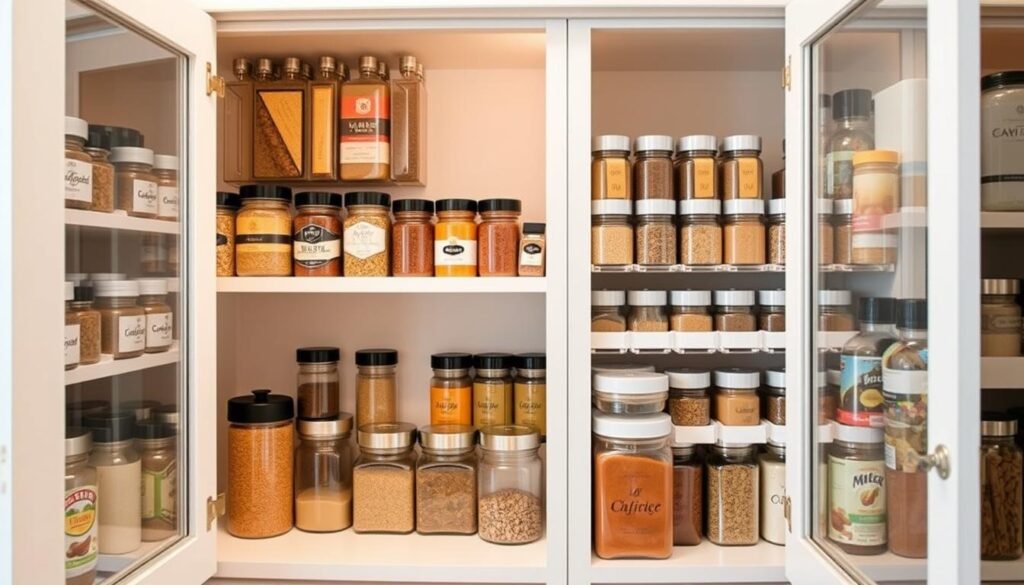
Transforming your pantry into a spice haven is easier than you think! Effective spice storage is crucial for a well-organized pantry, making cooking more efficient and enjoyable. You can maximize your space by utilizing the right storage solutions for your spices.
Visibility and Accessibility
Having your spices visible and accessible is key to a functional pantry. Consider using magnetic spice containers that can be attached to the side of a refrigerator or a metal pantry door, turning unused surfaces into valuable storage space. This approach not only saves space but also keeps your spices within easy reach.
Space-Saving Solutions
For small pantries, it’s essential to maximize space. Spice gripper clips that attach to cabinet doors are a great space-saving solution, utilizing otherwise wasted space. You can also opt for stackable spice organizers that make the most of vertical space while keeping labels visible. Drawer inserts with angled compartments are another excellent option, allowing for easy label reading while maximizing drawer capacity.
To further optimize your pantry’s storage potential, consider wall-mounted spice racks for narrow pantry walls or the inside of pantry doors. Evaluating your cooking habits will help you determine which spices deserve prime real estate versus those that can be stored more remotely. For compact storage needs, nesting spice jars or multi-tier rotating organizers with small footprints are ideal.
By implementing these spice storage strategies, you’ll not only maximize space in your pantry but also enhance your overall cooking experience. Whether you’re a seasoned chef or a culinary novice, a well-organized pantry is the foundation of a more enjoyable and efficient kitchen.
Drawer Systems and Pull-Outs
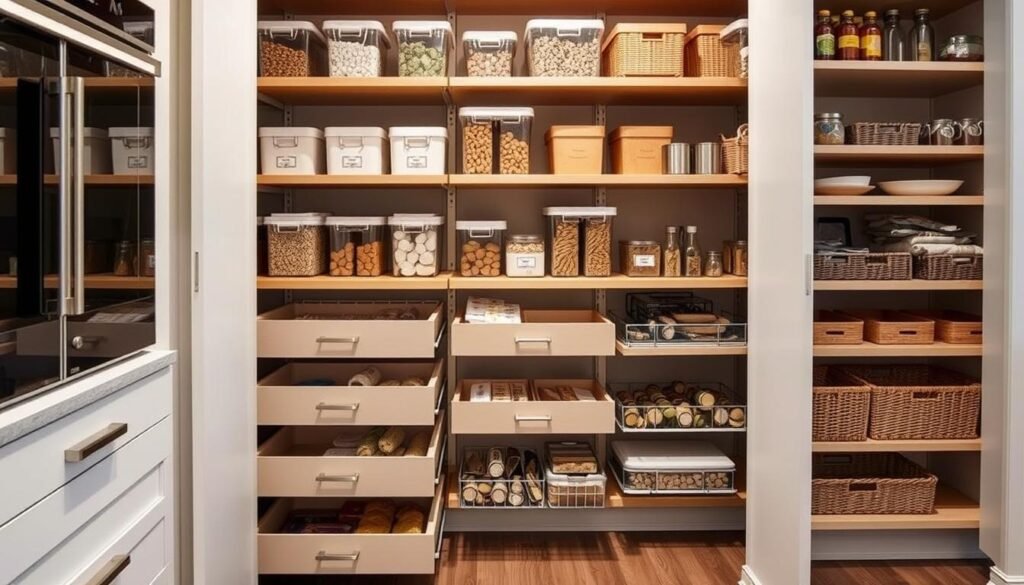
When it comes to pantry organization, the right drawer system can make all the difference. You’ve probably struggled to reach items pushed to the back of your pantry. Follow the lead of IKEA hackers and add drawers, or take a cue from Emily Henderson’s organized kitchen designs and turn your cabinets into pull-outs.
Benefits of Drawer Organization
Drawer organization offers numerous benefits, including improved accessibility and reduced clutter. By incorporating drawers into your pantry, you can keep items off shelves and make the most of your storage space. This is particularly useful in the kitchen, where efficient storage is crucial.
Custom vs. Ready-Made Options
When deciding on a drawer system, you have two primary options: custom or ready-made. Custom drawers offer a perfect fit and material choices, while ready-made solutions are more budget-friendly and immediately available. Consider your specific storage needs and budget before making a decision.
For a more tailored approach, you can opt for semi-custom solutions like IKEA cabinets with custom fronts. Alternatively, start with ready-made drawer organizers in one section to test the system before investing in a complete custom solution.
By incorporating effective drawer systems and pull-outs into your pantry design, you can create a more functional and efficient space that makes cooking and meal prep a breeze.
Lighting Your Pantry Effectively
Lighting your pantry effectively is crucial for making the most of your storage space. A well-lit pantry not only enhances visibility but also makes it easier to find what you need, when you need it.
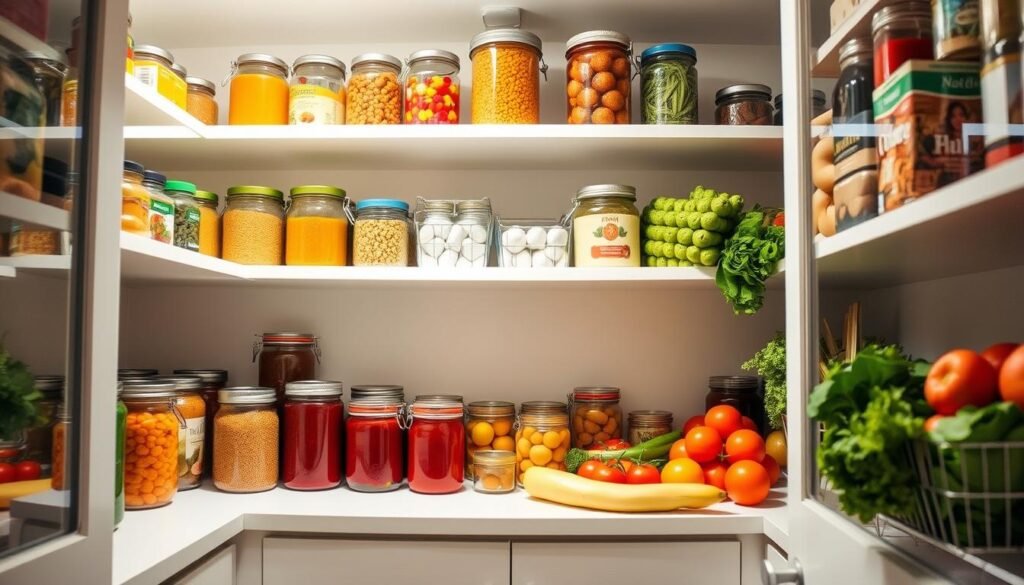
Types of Pantry Lighting
You have several options when it comes to pantry lighting. For a DIY-friendly approach, consider battery-operated puck lights or adhesive LED strips. These are easy to install and don’t require electrical expertise.
For a more permanent solution, hardwired lighting can be installed. However, it’s essential to consult an electrician to ensure the job is done safely and correctly.
Installation Tips
When installing pantry lighting, consider the placement of your lights carefully. Strategic placement under upper shelves can help eliminate shadows on lower shelves, making it easier to see everything.
Before making any permanent installations, test your lighting setup to ensure all areas of your pantry are well-lit. This will help you avoid any dark spots and ensure your pantry is both functional and inviting.
To make the most of your pantry’s space, consider using ultra-thin LED strips or recessed fixtures. These options provide excellent lighting without taking up valuable storage space.
For pantries without electrical outlets, don’t worry! You can still achieve great lighting with battery-operated solutions or by using extension cord management techniques.
Finally, coordinate your lighting with other pantry elements to achieve both functional and aesthetic benefits. This will help create a pantry that’s not only well-organized but also a joy to use.
Aesthetic Touches for a Beautiful Pantry
A well-designed pantry is not just about storage, it’s about creating a space you love. To elevate your pantry’s style, consider adding some personal touches that reflect your home‘s aesthetic.
Color Coordination
Using a cohesive color scheme can make your pantry look more organized and visually appealing. You can achieve this by selecting storage containers and decorative elements that match or complement your kitchen’s color palette.
Decorative Elements That Don’t Sacrifice Function
Incorporating decorative elements like wooden cutting boards, glass dispensers, or ceramic canisters can add a touch of warmth to your pantry while maintaining its functionality. Consider using decorative baskets and containers that complement your home‘s style while providing necessary storage. For more ideas, you can explore different design inspirations online.
As the saying goes, “A place for everything, and everything in its place.” A beautiful pantry is not just a storage area, it’s a space that inspires you to cook and create. By incorporating aesthetic touches, you can make your pantry a design feature in your kitchen.
“The way we organize our space reflects our personality and style.”
| Decorative Element | Functionality | Aesthetic Appeal |
|---|---|---|
| Wooden Cutting Boards | Preparatory surface | Rustic charm |
| Glass Dispensers | EASY access to ingredients | Modern look |
| Ceramic Canisters | Storage for dry goods | Classic style |
Conclusion: Maintaining Your Organized Pantry
Now that you’ve explored various pantry storage solutions, it’s time to bring them all together and create a system that works for you. A well-organized pantry can save you time and make cooking more enjoyable. To maintain your newly organized space, schedule quarterly “check-ups” to assess what’s working and clear out expired items.
Involve your household in maintaining the system to ensure long-term success. Start with one section at a time if a complete overhaul feels overwhelming, and adapt these pantry organization ideas to your specific needs and kitchen layout. The goal is a functional system that works for you, not perfection. Share your ideas and pantry transformation experiences in the comments below!
FAQ
How can I maximize my kitchen’s vertical space for pantry items?
You can maximize your kitchen’s vertical space by using wall-mounted shelves, installing ceiling-height storage units, or utilizing stackable containers to keep your pantry items organized and within reach.
What type of containers are best for storing dry goods like pasta and rice?
Clear containers or glass jars with lids are ideal for storing dry goods, as they allow you to see the contents and keep them fresh. Look for containers with airtight seals to maintain freshness.
How can I keep my pantry organized and clutter-free?
To maintain a clutter-free pantry, regularly declutter expired or unused items, categorize your pantry items, and use labeling systems to ensure everything has its designated place.
What are some effective ways to store canned goods and other heavy items?
Consider using tiered shelving or pull-out solutions to store canned goods and heavy items, making it easier to access them without having to dig through the entire shelf.
How can I make my pantry more kid-friendly?
Create a kid-friendly pantry by setting up accessible snack stations and using containers or baskets that are easy for kids to open and close, promoting independence and making snack time more efficient.
What are some space-saving solutions for storing spices and oils?
You can use wall-mounted spice racks or rotating spice carousels to maximize corner spaces and keep your spices and oils organized and within reach.
How can I maintain my pantry’s organization over time?
Schedule regular tidying sessions to maintain your pantry’s organization, and consider implementing a “one in, one out” policy to prevent clutter from building up again.
